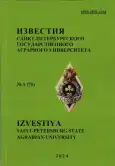Biometric Indices of Stem of Early Maturing Varieties of Long-Stalked Flax (Linum usitatissimum L.) under Conditions of Leningrad Region
- Authors: Nosevich M.A.1, Al Merri J.1
-
Affiliations:
- Saint-Petersburg State Agrarian University
- Issue: No 1(75) (2024)
- Pages: 9-16
- Section: Agronomy, forestry and water management
- URL: https://journals.rcsi.science/2078-1318/article/view/304756
- DOI: https://doi.org/10.24412/2078-1318-2024-1-9-16
- ID: 304756
Cite item
Full Text
Abstract
Research on the topic under study was carried out on a small experimental field of the Department of Plant Science named after I.A. Stebut of Saint-Petersburg State Agrarian University in 2021-2022. The objects of the field experiment were early maturing varieties of long-stalked flax (Linum usitatissimum L.) Zaryanka, Peresvet and organomineral fertilizers. The two-factor experimental design included 18 options. The purpose of the research is to establish the effect of organomineral fertilizers on the biometric indicators of the stem of early maturing long-stalked flax varieties. The main objective of the research was to determine the effect of organomineral fertilizers on the biometric indicators of the stem of early maturing long-stalked flax varieties. Weather conditions during the years of the experiments were not the same. The hydrothermal coefficient in 2021 for varieties was 0.6 (Zaryanka) and 0.93 (Peresvet), which characterizes the growing season of the crop as arid. During the growing season of long-stalked flax in 2022, the HTC amounted to 1.26 and 1.25, respectively, for the varieties, which characterizes (according to Selyaninov) the growing season as normal moisture. When performing experimental work, the experiments were carried out according to the requirements of generally accepted methods of experimental work. The results of the research showed that on average for 2 years the highest indicator of total length of 59 (variety Zaryanka) and 70 cm (variety Peresvet) was distinguished by long-stalked flax on the background where mineral fertilisers in the dose N10P20K40 and organic fertilisers humates were applied together. When analysing the stem diameter, no significant differences were observed between varieties and fertilizer backgrounds, as this indicator varied in a small range and was 1.1 to 1.4 mm in the experiment variants. In the experiment, there was no dependence between diminution and studied agrotechnical methods, as this indicator was at the same level - from 0.5 to 0.8. The application of humates in the studied varieties of long-stalked flax contributed to an increase in the ratio of the technical length of the stem to its diameter. Thus, in the conditions of the Leningrad Region the best technical data of the long-stalked flax had the variety Peresvet on the background of application of N10P20K40 and humates. The total stem length in this variant was 70 cm, technical stem length - 61 cm, diameter - 1.4 mm, diminution - 0.7 mm and the ratio of the technical length of the stem to its diameter - more than 440 units.
About the authors
M. A. Nosevich
Saint-Petersburg State Agrarian University
Email: mnosevich@yandex.ru
Cand. Sci. (Agric.), Associate Professor, Associate Professor of the Department of Plant Industry named after I.A. Stebut
Pushkin, Saint Petersburg, RussiaJ. Al Merri
Saint-Petersburg State Agrarian University
Author for correspondence.
Email: jasminealmerri6@gmail.com
Postgraduate Student
Pushkin, Saint Petersburg, RussiaReferences
- Dmitriev, A.A., Krasnov, G.S., Rozhmina, T.A. et al. (2019), ‘Flax (Linum usitatissimum L.) response to non-optimal soil acidity and zinc deficiency’, BMC Plant Biology, vol. 19, № S1, р. 54. doi: 10.1186/s12870-019-1641-1.
- Dmitrevskaja, I.I., et al. (2015), ‘The effect of long-term use of fertilizers on the yield of flax and fiber quality’, Achievements of science and technology of the agro-industrial complex, vol. 29, no. 10, pp. 50–52. (In Russ.).
- Savoskina, O.A., Chebanenko, S.I., Zavertkin, I.A., Shitikova, A.V. and Kudryavtsev, N.A. (2023), ‘The manifestation of diseases and phytophages of weeds associated with the cultivation of flax, the possibility of their use as biological plant protection agents’, BIO Web of Conferences, 78, 04001. MTSITVW2023 https://doi.org/10.1051/bioconf/20237804001.
- Korepanova, E.V., Goreeva, V.N., Chirkova, U.K. (2021), ‘Productivity and fiber quality of flax varieties in the conditions of the Ural Region of the Non-Chernozem zone of Russia’, AgroEcoInfo: An electronic scientific and production journal, no.6. (Electronic journal). URL: http://agroecoinfo.ru/STATYI/2021/6/st_631.pdf. DOI: https://doi.org/10.51419/20216631 (аccessed: 10 July 2023). (In Russ.).
- Pavlova, L.N., Gerasimova, E.G., Rumjanceva, V.N. (2018), ‘The importance of the variety in increasing the yield and quality of flax products’, Scientific support for the production of SPINning crops: state, problems and prospects. Tver: Tver State University, pp. 23–25. (In Russ.).
- Sorokina, O.Ju. (2020), ‘The effectiveness of traditional, new complex and organomineral fertilizers for flax’, Plodorodie, no. 1, pp. 8–11. doi: 10.25680/S19948603.2020.112.03 (In Russ.).
- Sorokina, O.Ju. (2021), ‘Evaluation of the range of fertilizers and methods of their application for a new variety of flax-dolgunts Universal’, Agrarnaja nauka, no. 6, pp. 55–59. https://doi.org/10.32634/0869-8155-2021-350-6-55-59 (In Russ.).
- Sorokina, O.Ju. (2023), ‘The effect of bacterial fertilizers in combination with mineral and organomineral fertilizers on the productivity of flax’, Plodorodie, no. 4, pp. 75–77. doi: 10.25680/S19948603.2023.133.18. (In Russ.).
- Dospehov, B.A. (2011), Metodika polevogo opyta (s osnovami statisticheskoj obrabotki rezul'tatov issledovanij) [Methodology of field experience (with the basics of statistical processing of research results)], Al'jans, Moscow, Russia.
- Nosevich, M.A., Novohackaja, D.M. (2015), ‘Technical assessment of flax products depending on the use of biological products, varietal characteristics and seeding rates of flax’, The scientific contribution of young researchers to the preservation of traditions and the development of agriculture: A collection of scientific papers of the international scientific and practical conference of young scientists and students. Part III. St. Petersburg: SPbGAU, pp. 9–11. (In Russ.).
Supplementary files









